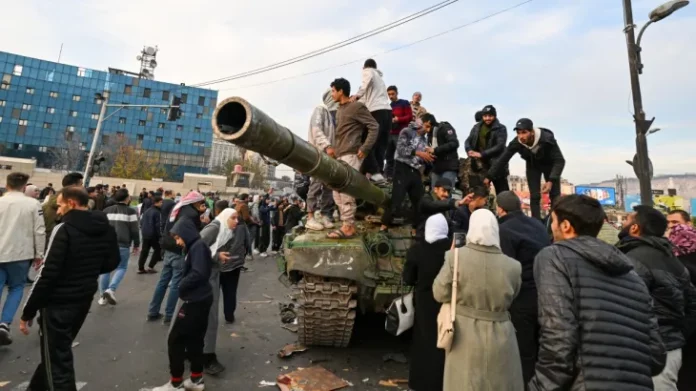Syrian dictator Bashar al-Assad has fled the country after rebel forces captured Damascus, marking a dramatic end to his family’s five-decade rule.
Reports from Syrian state television confirmed that Assad, along with his British-born wife Asma and their three children, escaped the capital on Saturday night.
Their destination remains unknown, and Syrian Prime Minister Mohammad Ghazi al-Jalali admitted on Sunday that the government lost communication with the Assad family.
In Damascus, thousands of jubilant citizens filled the streets to celebrate the collapse of the regime.
Some chanted slogans against Assad while others fired celebratory gunshots into the air.
Rebel forces have called on Syrians to safeguard state institutions and maintain order.
A group calling itself the Operations Room to Conquer Damascus announced Assad’s downfall in a video broadcast.
“Long live the free Syrian state,” one of the men declared, urging unity among all sects and ethnicities.
The fall of Assad comes after nearly 14 years of a devastating civil war that claimed over 500,000 lives and displaced millions.
The war began in 2011 during the Arab Spring protests when Assad’s brutal crackdown on pro-democracy activists ignited widespread unrest.
Experts describe the ousting of Assad as a monumental moment in Middle Eastern history.
It signals the end of one of the region’s most controversial dynasties.
The Assad family has ruled Syria since 1970, with Bashar inheriting the presidency in 2000 after the death of his father, Hafez al-Assad.
However, the coalition that ousted Assad has raised serious concerns among global powers.
The rebel forces include Hayat Tahrir al-Sham (HTS), a U.S.-designated terrorist group with roots in Al-Qaeda.
HTS, led by Abu Mohammed al-Golani, played a decisive role in the swift takeover of major Syrian cities like Aleppo and Homs.
Al-Golani, once a detainee of the U.S. military, has attempted to rebrand himself as a more moderate leader.
But analysts warn that HTS’s vision is rooted in establishing a strict Islamist regime similar to the Taliban.
Phillip Smyth, a Syria expert at the Atlantic Council, described HTS’s goals as “totalitarian” and deeply concerning.
“They aim to create a society with the same harsh controls seen in Afghanistan,” he said.
The capture of Damascus also has geopolitical implications.
Iran and Russia, key backers of the Assad regime, have suffered significant blows.
Russia’s involvement in Syria since 2015 helped stabilize Assad’s rule, but Moscow’s focus on its war in Ukraine has weakened its influence.
Iran’s support for Assad has also drawn Israeli airstrikes targeting its military installations in Syria.
The Syrian conflict has long been a proxy battlefield for global powers.
Assad’s downfall could further destabilize the region, sparking new conflicts among rival factions.
International leaders are now watching closely as the country enters an uncertain phase.
The United Nations had proposed Resolution 2254 in 2015, calling for a ceasefire, democratic elections, and a new constitution.
Assad refused to implement the resolution, prolonging the suffering of his people.
The origins of his downfall trace back to the small town of Daraa in 2011, where schoolboys spray-painted anti-government slogans on a wall.
Their arrests and torture sparked a nationwide uprising, eventually leading to the bloody civil war.
Assad’s use of chemical weapons against his citizens in 2013 was one of the darkest chapters of the conflict.
More than 1,400 people died in a single attack, prompting international outrage.
Despite initial promises of intervention, the U.S. did not take military action, emboldening Assad to continue his brutal tactics.
Egyptian and Jordanian officials reportedly urged Assad to leave the country earlier this year and establish a government-in-exile.
For now, his exact location remains a mystery.
As Syria celebrates the end of one chapter, it braces for the uncertainties of another.

